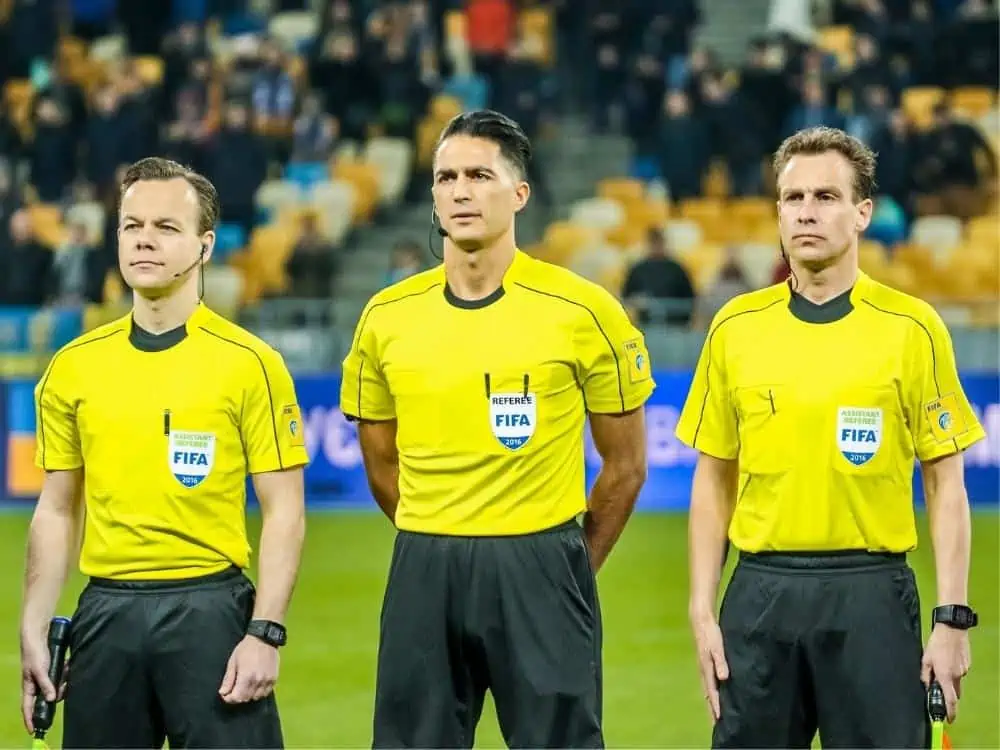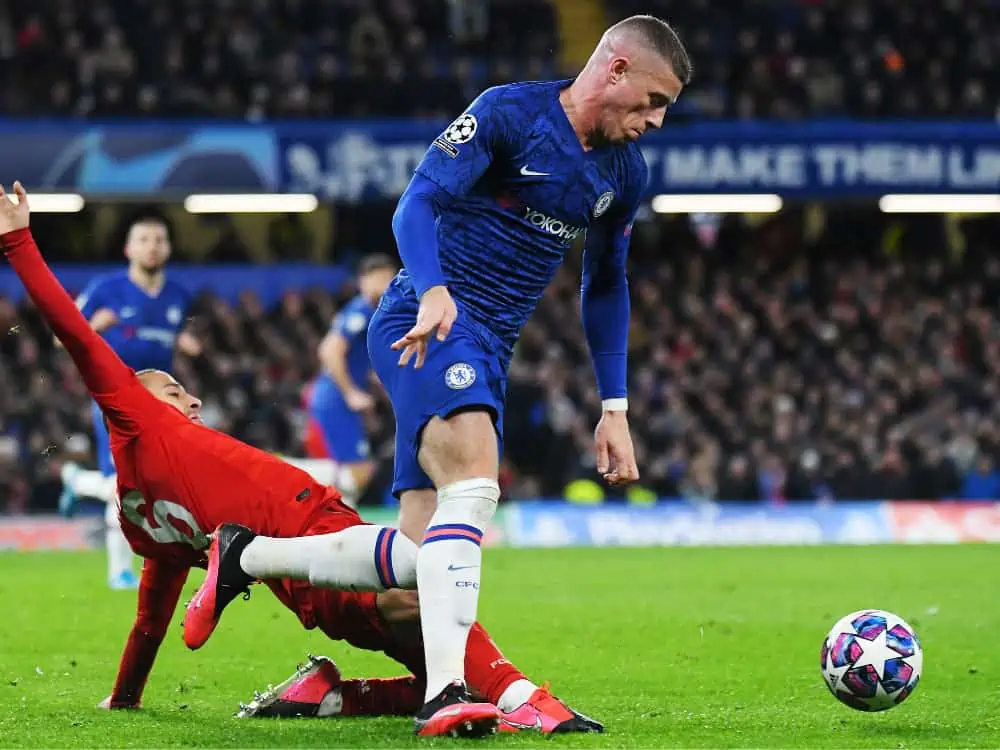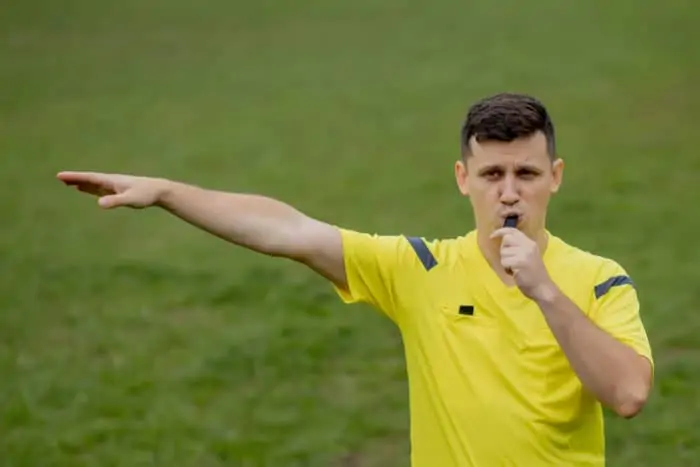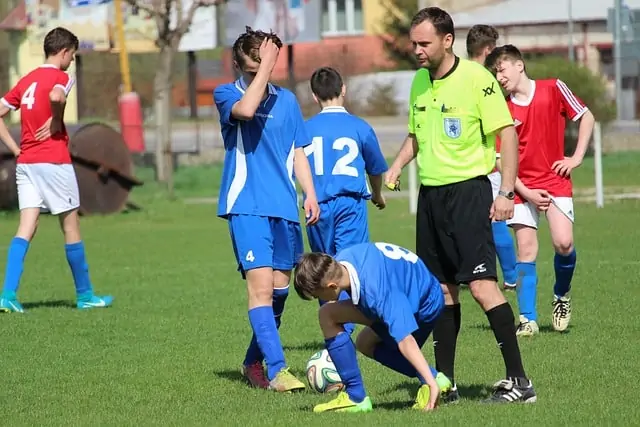Share the post "What Is Advantage in Soccer? (Great Rule)"
You’re watching your favorite soccer team go at it. They’re doing all the right things as they build their play. Everyone is anticipating a scoring opportunity. One of your team’s players is fouled, but the play continues. You wonder, what is happening?
That is the advantage rule in play. The advantage rule in soccer states that the game should not stop as long as the fouled team is in possession of the ball. Hence the name ‘advantage”.
An advantage cancels out a foul play and the game continues as normal. In many cases, an advantage provides an opportunity to score, especially if the opposite team has a slow reaction time or if a foul happens near the goal post.
In this article, we’re going to look at the following:
- How does the advantage rule work in soccer?
- Examples of advantages of play scenarios
- How is the advantage rule signaled?
- Where to play advantage from
- What next after the ref books a player after playing advantage?
- Advantages and disadvantages of the “advantage rule” in soccer?
Read on and learn comprehensively about the advantage aspect in soccer, and maybe the next time you and your pals are watching this beautiful game, and an advantage is awarded, you will be in a better position to explain what it’s all about.

- Is Advantage a Rule in Soccer?
- Why Does the Advantage Rule Exist?
- How Long Does the Advantage Rule Last?
- Examples of Advantage Advantage Play
- How Is the Advantage Rule Signaled?
- Can You Play Advantage After Handball Call?
- Can You Play Advantage for a Penalty?
- Can You Play Advantage From a Foul Throw?
- Can the Referee Book A Player After Playing Advantage?
- What Are the Advantages and Disadvantages of the “Advantage Rule” in Soccer?
- Can a Player Receive Two Yellow Cards if an Advantage Is Played?
Is Advantage a Rule in Soccer?
The advantage rule dictates that a team that the foul is against shouldn’t lose their current advantage by stopping the soccer game.
For instance, if a team was playing a given set-piece and the buildup was significant, they gained substantial yards against their opponents and managed to open up their defense.
If a player of the team is fouled and, by the referee’s judgment, the team will lose their attack momentum; the referee can play on advantage to allow the team to finish their play because it might result in a significant attack.
Law 5
Under the powers and duties of law 5, the “referee allows the game to continue when a foul is confirmed and that the fouled team will gain the advantage”.
If the fouled team does not gain from the advantage (not necessarily a score, but a continuation), the offending team is penalized. This can be through a set piece such as a free kick.
When the referee sees an advantage, he allows it to play on according to law 5. But they can also recall the foul if the team immediately loses their advantage.

Why Does the Advantage Rule Exist?
The reason the advantage rule exists is to favor the fouled team. Therefore, the official should call the foul when the fouled team loses the advantage. Then, the ball is given to them to restart it from the position of the offense.
Advantage also exists to stop the team at a disadvantage from committing fouls to halt play.
For example, a team might see that the attack developing against them has the potential to break them and then decide to commit a minor fall to stop play and give them time to catch their breath and realign themselves.
The advantage rule counters that way of thinking because the game will carry on to the benefit of the fouled team. If the play does not materialize immediately, the fouled team still has the advantage of the ball.
How Long Does the Advantage Rule Last?
The advantage rule only applies for two seconds in the game. Alternatively, when a player makes the pass to another team member. Then, it only lasts for the subsequent few touches.
If the referee decides that the team with the ball to play advantage, rather than stop for an infraction, then the decision is permanent and should not be brought back for that infraction if the game continues for a few more touches.
Examples of Advantage Advantage Play
There are several instances where the advantage rule may be applied, including fouling a player at midfield and fouling the player inside the defensive penalty box.
Fouling
A foul is a mistake that a team commits against an opposing team. When fouls occur, the referee will signal all the teams playing.
Let’s use a case where the defending team fouls the team in possession and the attacking team maintains possession of the ball; then, the advantage rule may apply.
In this case, the fouled team gets the go-ahead to continue playing the referee. The referee signals the fouled team to carry on playing by shouting, “Play on!” to the players.
Examples of fouls where the advantage rule may apply include:
- A foul at midfield- An advantage clause may be applied when the fouled team has many play areas and options for developing play.
- A foul outside the defensive team’s penalty area –Normally, if the referee sees an opportunity for goal scoring by the fouled team, he may let the game continue.
- A penalty kick foul inside the defensive team’s penalty area- The referee should allow the leeway of advantage rule only if the attacking player possesses the ball and has very high chances of scoring.

How Is the Advantage Rule Signaled?
Communication on the pitch is essential. For example, when a referee overlooks a foul, it is imperative that they correctly communicate it to the outside referees and the players.
The advantage play is given when the official puts both arms out horizontally in front of him. In this scenario, the defending team is not allowed to touch the ball.
If they go against this rule, the game stops, and a “free kick” is awarded to the fouled team.
The official should also give verbal directions by shouting, ‘play on’ or ‘keep playing’ to inform the players that advantage is in play.
Can You Play Advantage After Handball Call?
The advantage rule applies in soccer only when the ball is received and the attack looks promising with an opportunity to shoot and score; then, the ‘advantage rule’ is applied. The play continues without the referee blowing the whistle.
A handball foul would usually call for a free-kick. But free kicks need to be set up, and the teams have to rearrange themselves.
Then, if the fouled team loses a clear opportunity of advancing by doing so, the referee can call advantage on the handball.
Can You Play Advantage for a Penalty?
There is a probability but on a minimal scale. An advantage in the penalty area is very scarce, mainly because the referee only lets the game continue when the likelihood of scoring is high.
A penalty has more potency than a goal in many scenarios in the penalty box; therefore, calling advantage in the penalty box for a foul needs better discernment from the official.
Nevertheless, the foul is called in most cases, and the benefiting team takes the penalty.
Can You Play Advantage From a Foul Throw?
You cannot play advantage after an improperly taken throw-in. Unlike other fouls, a throw-in is not a foul committed when the ball is on momentum.
Therefore, if an advantage is awarded in a throw-in, a foul throw-in has to be retaken as a throw-in.
Can the Referee Book A Player After Playing Advantage?
If the referee or officials realize that the advantage will not materialize, then he has the right to blow the whistle and call the original foul.
Also, suppose the foul committed necessitates a warning or card from the referee.
In that case, the referee should allow the advantage to play on to the conclusion and then return to the fouling player and administer the necessary disciplinary action.
If there happens to be a next time where the gameplay stops, the referee may return to the player who committed the mistake a red card or yellow card.

What Are the Advantages and Disadvantages of the “Advantage Rule” in Soccer?
A coin usually has two sides, and the advantage rule has two sides. It has its pros and cons, and we shall dissect them respectively.
- The fouled team is often thrilled when signaled to continue possessing the ball. The game continues, and the player’s energy level, stamina, and motivation are not distracted, providing the players with leeway and a chance to score a goal.
- The team that has committed an offense may not be penalized for the infraction committed. They have to step up and catch up with the team’s playing advantage.
The ‘advantage rule’ is not only advantageous to the fouled team, but it can also prove disastrous. It has a negative side, including:
- Any foul breaks the team’s momentum, even for just a microsecond. So, for example, a team might play on advantage, but since the advantage is a two-second decision, after a few touches, it might be clear that the team did not benefit from the advantage.
- Unfortunately, a player that has been fouled may seriously be injured, and if the game continues, they might not be immediately attended to as is needed.
Can a Player Receive Two Yellow Cards if an Advantage Is Played?
Think of a scenario where a player commits a foul, but the referee allows for an advantage, and then the fouling player fouls another player during the advantage. Can a referee issue two yellow cards, hence a red card?
A referee should stop the game immediately after the second foul. If both mistakes are worthy of yellow cards, they might give the two yellow cards but clearly indicate that one yellow card is for the previous mistake and the second yellow card is for the current mistake.
The two yellow cards would result in the player being sent off.
Advantage should not be played on fouls that would result in a send-off unless a clear scoring opportunity exists.
Share the post "What Is Advantage in Soccer? (Great Rule)"
Joel is a seasoned soccer journalist and analyst with many years of experience in the field. Joel specializes in game analysis, player profiles, transfer news, and has a keen eye for the tactical nuances of the game. He played at various levels in the game and coached teams - he is happy to share his insight with you.



